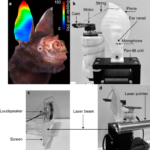Paper, Integration of deep learning and soft robotics for a biomimetic approach to nonlinear sensing
Traditional approaches to sensing have often been aimed at simple sensor characteristics to make interpretation of the sensor outputs easier, but this has also limited the quality of the encoded sensory information. Integrating a complex sensor with deep learning could hence be a strategy for removing current limitations on the information that sensory inputs can carry. Here, we demonstrate this concept with a soft-robotic sensor that mimics fast non-rigid deformation of the ears in certain bat species. We show that a deep convolutional neural network can use the nonlinear Doppler shift signatures generated by these motions to estimate the direction of a sound source with an estimation error of ~0.5°. Previously, determining the direction of a sound source based on pressure receivers required either multiple frequencies or multiple receivers. Our current results demonstrate a third approach that makes do with only a single frequency and a single receiver.
Learn about our two Decals!
 Click here to find out more about our Fall Bioinspired Design Decal and our Spring Bioinspired Design in Action Decal – ALL MAJORS are welcome.
Click here to find out more about our Fall Bioinspired Design Decal and our Spring Bioinspired Design in Action Decal – ALL MAJORS are welcome.Berkeley BioDesign Community
 Click here to learn about the BioD: Bio-Inspired Design @ Berkeley student organization or here to signup for more info.
Click here to learn about the BioD: Bio-Inspired Design @ Berkeley student organization or here to signup for more info.Search
Student Login




I imagine that the neurological circuits underlying these processes are governed by both 2d spacing maps with their brains as…
to reduce the impact of car accidents, it may be possible to study the force diverting physics of cockroaches to…
you see this type of head-bobbing stability in many avian creatures related to pigeons like chickens. the head ability to…
not like they taught horses how to run! this is an example of convergent evolution where both sea creatures and…
The brain functions in a similar way with neuronal connections. our brains are able to utilize the multiplicity of connections…